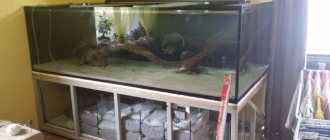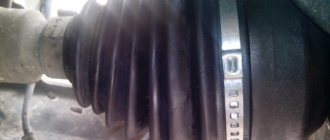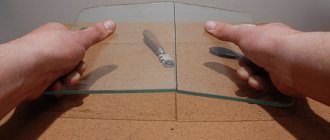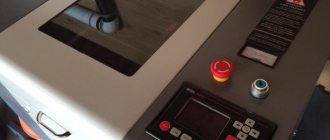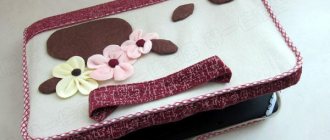I have a grinding machine in my workshop. Occasionally I use it to polish some parts. The last purchased ribbon from the set recently broke. I didn’t want to go to the store for new ones, so I decided to make my own from sandpaper. It turned out, by the way, very well, so next I want to tell you about how to glue the grinder tape with your own hands and a little about it itself.
Source pinimg.com
Which grinder belt to choose.
There are many sanding belts on the market that vary in price and quality. Abrasives from the most well-known manufacturers will be taken as examples.
If we consider the budget niche, then we should focus on the products of the BAZ Belgorod Abrasive Plant. Their products are quite cheap compared to other manufacturers. This manufacturer also has ribbons with ceramics. They are quite “aggressive” and are designed for processing hard, hardened steels. But the products of this manufacturer wear out quite quickly and begin to heat up. Metal dust cokes on the belt and begins to tear grooves on the workpiece being processed. This happens on all tapes, regardless of the manufacturer, but on products produced by BAZ everything happens much faster.
Better quality abrasives are produced by VSM and 3M. They have different series of grinder abrasives that are designed to completely finish the workpiece, from roughing to polishing. VSM products offer a good balance between price and quality. Products from 3M are distinguished by their high quality, wear resistance and high price. Products from 3M are better than VSM tapes, but their price is 30 percent more.
Below is a kit that can be used to process any steel. For example, process a blade and bring it to its final state.
On the Internet, many advise starting processing using P24 abrasive grain. This is the largest grain, which is intended for rough peeling of the workpiece. But it is better to start processing with finer grain P40 or P36. Logically, a large grain should process the material faster, but in practice, a large grain processes faster, and a belt with such grain shrinks faster than with P40 grain. P40 grain works more accurately; after processing, there are fewer deep marks on the workpiece, which are then difficult to remove.
For example, let's take products from the VSM company with P40 grain of the XK880Y series or from the 3M company of the Cubitron 2 series. These are series with ceramics for rough processing of material. Afterwards you will need a ribbon with P80 grain. The P80 abrasive removes the risks left from the P40 grain. Next, select abrasive grain P120. Belts with grain P60 and P100 are available for sale. But in order to save money, we skip them. It is not necessary to use all the grains in order.
At this stage, ceramics are no longer needed. Other abrasives are required for finishing.
As experienced experts advise, if you finished on ceramics with P120 grit, then you should also switch to a softer abrasive with 120 grit, but in order to save money, you can start with P180 grit.
The next series is the kk712x from VSM. The grain material is corundum compact grain, also called compound. This abrasive removes risks from the previous grain well, without leaving behind large marks. With other abrasives, there is a problem when P160 grain leaves marks on the workpiece, which are then difficult to remove. This most likely happens due to the fact that the tape cokes; there are no such problems with this abrasive. The only drawback of the compounds is that they quickly become unusable.
After the P180 compound, the next tape is the same series, but the P220 grain. In principle, you can end there; the blade will already have a marketable appearance, but it can be improved. For example, someone needs polishing. We choose the sk772t series and P320 grain. This is also a compound, but a finishing one. Its processing purity is higher. After P320, we move on to P400 abrasive and then P800.
If you want to get a mirror, then you should then use dialux pastes.
Above we presented a set for processing ordinary and hardened steels, but you need to understand that this set is not suitable for all cases. You need to know that each material has its own abrasive to process.
It is also important to understand that the shorter it is in length, the faster it wears out.
Tools and materials
You can find a variety of abrasive materials for grinders in stores; they are sold in rolls glued to specific sizes. But the required size is not always available in stock, so strips made independently are used to replace failed tape.
Craftsmen resort to different methods: using tape to connect abrasives, gluing with a hot-melt gun, reinforced tape, special glue, etc. The process is simple, but requires care.
Required materials and tools:
- abrasive sandpaper on a fabric basis;
- ruler;
- scissors;
- glue
- degreaser;
- weight for pressing the parts to be glued.
You can save on the purchase of grinder tapes if you purchase sandpaper for the job and glue it to the required dimensions. It is worth remembering that the smaller the strip, the faster it will become unusable - wear out.
To seal the tape, there are two main methods.
- Overlapping. The main advantage of this method is that the connection is very strong, and the gap is minimized. But there is also a drawback - during operation it will “hit” at the joint. There is an interesting pattern here: the larger the abrasive, the smaller the joint will be felt.
- Butt. Here everything turns out the other way around: for a seamless connection, the probability of rupture increases, but beating during operation will be minimized.
When choosing an abrasive belt for a grinder, you need to take into account the fact that each material and product has its own grain size. There are many emery cloths on the market, differing in price and quality.
Budget products from the manufacturer Belgorod Abrasive Plant (BAZ) have a fairly low price compared to other manufacturers.
The range includes products with ceramic coating, which, due to its “aggressiveness”, is used in metal processing. But the level of quality and service life of the BAZs are represented by average indicators; during operation they quickly fail and heat up. Dust from metals begins to coke on the canvas, causing scratches and grooves to form on the material being processed. This applies to all abrasives, but with the products of the Belgorod plant the process occurs faster.
Emery cloth from manufacturers VSM and 3M is of much higher quality. The range includes abrasives for both rough work and final polishing. The products of the manufacturers in question are of a higher level of quality, but ZM has a higher price.
Amateur craftsmen advise starting work with rough grinding grain - P24. This is the largest size. But experienced craftsmen say that P36 and P40 are better options for the initial stage of work. Belts with coarse abrasives fail faster.
For the next polishing stage, sandpaper size P120, P160 or P180 is suitable. If the product requires polishing, then the next dimension will be P320 - this blade is intended for finishing. And then it is necessary to continue working with sizes P400, P800.
To clean the emery cloth, you can purchase a rubber pencil; with its help, you can remove dust that begins to coke from the abrasive.
This way the sanding strip for the grinder will last longer.
How to glue grinder tape.
Tapes will cost much less if you buy sandpaper and glue it to the required length.
There are two main gluing methods with minor variations:
1) Overlapping gluing.
The obvious advantage of overlap gluing is that the tape sticks very well and the likelihood of it breaking at the gluing site is minimal. The disadvantage is that during operation it “hits” at the joint. Moreover, there is a certain pattern: the larger the abrasive grain, the less the joint is felt.
When gluing end-to-end, everything turns out the other way around. There is practically no runout at the gluing site, but the quality of the connection is worse and the likelihood of rupture is higher.
Gluing the tape with an overlap.
To glue in this way, it is necessary to remove the abrasive at the gluing site. There are two options here. You can remove the abrasive grain from only one end or from both ends of the belt.
If you remove, on the one hand, the tape will end up with solid abrasive grain along its entire length, but there will be noticeable beating during operation.
If you remove it from both sides, the runout is significantly reduced, we can say that there will be practically no runout, but a section without abrasive will form at the gluing site. This is bad because there will be increased wear in this place. Therefore, this type of gluing is used when processing soft materials, such as wood.
Gluing should be done at an angle. This gluing increases the length of the glued seam, which increases the strength of the gluing area and reduces the likelihood of the edge of the tape scuffing. The angle can be arbitrary from 30 to 45 degrees.
First you need to loosen the sandpaper.
Source
Gluing tape
A strip of the required width and length is torn from the sandpaper.
One of its edges under the ruler is cut at approximately 45 degrees.
The second edge is marked and trimmed along it. You should not glue tape with straight ends, since in this case the contact area will be smaller, which will reduce the reliability of the connection.
One end of the tape, approximately 15-20 mm from the edge, is bent inward at an angle of 45 degrees.
The abrasive along the fold line is picked off with a knife.
A similar bend is made on the second edge of the tape. To make it the same width, you need to measure along the first crease. The abrasive along the line of the second bend is also torn off with a knife.
Next, you need to remove the abrasive over the entire area of the folded edges.
To do this, they are heated to soften the bakelite glue.
This can be done using a vulcanizer for repairing cameras or an iron. You need to heat the edges to a temperature of at least 150-160 degrees Celsius, which only modern irons with a drip system set to maximum power are capable of. Old Soviet irons heat up to a maximum of 115 degrees Celsius, so they won’t work. The edges of the tape are heated for 10-15 seconds until they darken, after which the abrasive is easily scraped off with a knife.
To glue the stripped ends of the tape, glue 88 is used. After applying it and spreading it on the fabric, you need to wait about 5 minutes. After the glue stops sticking to your fingers, apply a second layer and rub it again by rubbing the edges of the tape. It is necessary to achieve complete impregnation of the fabric so that it becomes rigid. After waiting another 5 minutes, you should reconnect and break the ends, smearing the remaining protruding glue.
After another 5 minutes, the tape is finally connected. You need to check how even the ring is and, if necessary, trim it. After this, the gluing area is compressed in a vulcanizer or clamped with a regular clamp through a spacer. The tape is left under pressure for 24 hours. After complete polymerization of the glue, it can be used for its intended purpose.
How to glue grinder tape with your own hands: 5 useful tips
Belt grinders (grinders) are used for finishing processing of wooden and metal workpieces, as well as for sharpening cutting tools in a garage or home workshop.
Moreover, they can be of different designs - both with a horizontally located working platform and a vertical one.
Depending on the type of work being performed, the master chooses the first or second option.
You can read more about how to make your own belt sander here.
In this article we want to talk not about the machines themselves, but about consumables for them. Specifically, about the sanding belt for the grinder, without which the use of the machine becomes impossible.
Sequencing
The main stages of this work are:
- Sandpaper cutting.
- Installing a sheet of metal in a vice.
- Trimming the ends of the tape.
- Removing abrasive from its corner.
- The final stage is gluing.
Let's look at each of them in more detail.
Trimming
The tape is cut with any tool, you can use ordinary scissors. Before starting preparation, you need to make a cut line on it using a ruler and pencil (it is required that it be as even as possible).
Having completed the preparation stage, you can begin cutting.
Installing the support in a vice
During the entire gluing process, it will be convenient if a thick piece of metal is inserted into a vice; corners will need to be laid out on it during preparation and gluing. Therefore, you need to firmly secure it in them.
Note! The metal sheet must be made of a material capable of withstanding the temperature of the gas burner.
Preparing the corners of the tape
The end of the sandpaper is laid out on the prepared area. It needs to be cut at an angle. At a distance of 3-4 cm from the edge, draw an oblique line with a pencil.
Note! For better stability, you can place a magnet on top of the paper.
The second end is simply cut at a similar angle.
Removing abrasive
At a distance from the edge of the prepared end to approximately 4 cm, it is necessary to remove the dust from the sandpaper.
You need to prepare a tape with the same thickness, about 10cm in length.
Next, the algorithm of actions is as follows:
- the gas burner adjusts the fire supply under the metal “table”,
- it heats up simultaneously with the sheet of paper placed on it,
- when everything is warm enough, the burner turns off,
- the hot corner must be coated well with a silicone corner to the drawn line,
- A piece of sandpaper is firmly applied on top and secured firmly (you can put some kind of press.
After some time (5-10 minutes), the load is removed. You need to tear off the second piece, which has stuck tightly and, having been torn off, will take on all the abrasive, cleaning the edge of the desired tape.
Gluing
When the gluing area is ready, it can be fastened to the second end.
The manipulations will be similar to the previous stage:
- The site and material are heated using a gas burner.
- A hot, clean area is coated with silicone.
- The second end is overlapped on top.
- A load is placed on the resulting circle, under which the joint will dry out.
When all the material has cooled and dried, a full-fledged grinder belt will be ready and can be used.
This way you can get an excellent homemade belt for your sanding machine. This method is the fastest, unlike other similar ones, since silicone dries much faster than the glue used in similar methods. You just need to have the tools and material for this.
If you have made yourself a grinder or bought one, then you may have some questions. For example, what abrasive tapes should you buy for the grinder, and can you glue them yourself? You will find answers to these questions in the text below. How to make a grinder, select the engine power and calculate the diameter of the grinder drive roller, you can read in this article>>>
Preparing the corners of the tape
To ensure that the sanding tape glued together by yourself does not tear during sanding at the first use, and generally lasts as long as possible, it is necessary to properly prepare the edges of the cut strip of sandpaper.
But let's talk about everything in order. First of all, the edges of the sandpaper need to be cut at an angle of approximately 30-35 degrees. Some craftsmen make an angle of 45 degrees.
After cutting the edges of the tape at a given angle, use a ruler to measure 2 cm, and then bend one of the edges. You will get a corner.
At the next stage, the curved edge of the sanding belt, which will be located at the bottom, must be cleaned of abrasive grain.
There is no need to clean the abrasive on the other side of the sanding belt, but it is advisable to remove a small chamfer at the very edge for high-quality gluing.
However, some home craftsmen remove abrasive from both sides of the tape at once in order to reduce runout when processing workpieces.
Before gluing, on the back side of the sanding belt (where the fabric base is located), you need to sand a narrow strip equal to the width of the bend at the opposite end of the tape - usually 2 cm.
Removing abrasive
If you do not first clean the abrasive on one of the edges of the sanding belt, you will not be able to properly glue the edges of the strip.
If you clean the abrasive poorly, then a bump will protrude on the sanding belt itself, and with intensive use in this place it will tear very quickly, and there will be decent runout.
There are several ways to clean abrasives. For example, a piece of saw blade for a hacksaw will do.
However, as practice shows. This can be done much faster using an electric sharpener (just be sure to work in a respirator and safety glasses).
Let's look at the most popular methods of removing abrasive from sandpaper, which are used by home craftsmen.
Iron method
Using an electric sharpener (sharpening machine) you can quite quickly clean the abrasive on the surface of the sandpaper, but still this method is not applicable in all situations - a lot of dust is generated.
And if there is no hood installed in your home workshop or garage and there is no way to properly ventilate the room, then you definitely shouldn’t use it.
Alternatively, you can try to clean the abrasive using a regular household iron. That is, in this case we will heat the sandpaper and then scrape it off with a knife.
The iron will need to be positioned with the sole facing up. To do this, we clamp it in the desired position in a bench vice.
After the iron has heated to the desired temperature, apply sandpaper to its surface and gradually clean off the abrasive using a knife or a piece of metal saw blade.
Removing abrasive with acetone
To make it easier to remove the abrasive manually - for example, using a regular knife, the surface of the sandpaper at the bend must be generously moistened with acetone and left for about 5-7 minutes.
During this time, the acetone will be absorbed into the sandpaper, and it will be much easier to remove the abrasive. Tested in practice.
The disadvantage of this method is that acetone has a very strong odor. It is better not to use acetone in a closed and poorly ventilated room - it may cause a headache.
If you need to glue 1-2 sanding belts, then it’s okay - you can be patient, but if there are several dozen belts, then it’s better to do the impregnation with acetone outside or with the windows wide open.
Gluing
There are several practice-tested methods for gluing sanding belts for a grinder or sander. One of them is that you can glue the tape through the lining.
To do this, a piece of fabric is placed underneath the sandpaper (for example, you can use silk, cambric, satin, nylon or other durable material), and the edges of the strip are then glued end to end and held in place with a patch.
However, most often home craftsmen prefer to glue the sanding belt overlapping.
Let's look at both of these methods, and you can decide which one suits you best for gluing tape.
Gluing overlapping tape
Once you have cut the edges at an angle and removed the abrasive on one end of the sanding belt, you can begin gluing.
It is important to determine the width of the overlap. It is optimal to overlap no more than 2 cm.
We fold the strip of sandpaper in half, having previously leveled the gluing area. We additionally secure the edges with clothespin clips.
To glue the sanding belt, you can use PVA glue D3.
Apply glue to the prepared areas of the sanding belt, spread it evenly, and overlap the ends of the strip.
We also apply a small amount of glue to the end of the upper edge of the tape.
We place pieces of paper or old newspaper below and above the gluing area so that the sanding belt does not stick together.
After this, we apply wooden blocks or pieces of plywood on both sides and clamp them with clamps. Leave it in this state for a day.
For details on how to glue overlapping grinder tape, watch the video below. The author of the YouTube channel StoDel_56 shared his experience.
By putting this gluing method into practice, you will get a reliable and strong connection.
PVA glue D3 is excellent for gluing paper and fabric sandpaper. Neither strong pressure nor heat will cause the sanding belt to tear at the gluing site.
What is needed for gluing sandpaper
Ready-made abrasive belts for home grinding machines are purchased in stores. But the price for them is quite high and you can’t buy them in all regions.
Accordingly, it is better and cheaper to make the abrasive tape yourself, because the required size is not always available at points of sale. This is due to the fact that many home sanders have non-standard sizes.
Many craftsmen glue the tape tightly, placing a sandpaper pad at the bottom.
However, I find it better to create an overlap seam. How to glue an abrasive belt for a sandpaper grinder and what will you need for this?
Equipment for working with paper:
- PVA glue (class D3);
- Acetone;
- Part from a hacksaw for metal;
- Small wooden board;
- Pieces of newspaper;
- Clothes clips;
- Clamps.
First of all, you need to cut the sandpaper into strips of the required width.
The length is separated with a margin, taking into account the overlap, which is two centimeters. The angle should be “friendly” with the diameter of the installed machine rollers.
Before gluing, one of the parts of the sanding strip should be cleaned of abrasive. To do this, you need to moisten the gluing area with acetone and wait a few minutes. Then, remove the “grains” with a hacksaw saw blade.
It is worth removing a small chamfer from the second end of the sandpaper for better gluing. In addition, it is necessary to clean the “sandpaper” from the wrong side. This side also needs to be sanded; if this is not done, the bonding will be much worse.
Next, after the acetone has completely dried, you can begin gluing the abrasive strip for the grinder.
The edges of the tape must be secured with clamps so that they do not move apart in different directions. Then you need to coat the fastening area with PVA wood glue.
It is best to use class D3. The glue should be spread in a thin layer over the surface.
Place pieces of newspaper on the top and bottom sides and press down with a board. Next, you should compress it with clamps and leave it for a day. After this, the abrasive tape is ready to use, but it is better to let it dry for another day.
Then, you need to remove the clamps and board and remove the pieces of newspaper. There is no need to worry that some of them will remain - when working with a grinding machine, they will fly off on their own.
In this simple way, you can glue sanding tape without having to buy an expensive abrasive tape. This is especially important when its dimensions at the point of sale do not match the dimensions of the home grinder.
What type of glue for sandpaper adhesion would you recommend?
Gluing overlapping belts for a sander at home
The following prompted me to search for information and further experiments.
1. Assortment. In my work, I am used to using 4 types of sandpaper grit: 40, 80, 100 and 150. In the 3 years of using my sander, I have never seen ready-made belts with a grit of 40 and 150. Perhaps they exist in nature.
2. Price. One ready-made belt for a Jet or Zubr garage sanding machine costs a little more than 100 rubles. A square meter of sandpaper costs an average of 250 rubles, from which 10 tapes can be made. A more than fourfold reduction in the cost of consumables is a serious motivator for me.
3. Overhead costs. I brought 40 meters of sandpaper in rolls from the nearest hardware store - I made 100 tapes of 4 types - I forgot about the sanding belt for six months. In my conditions, the closest one is 20 km away. — every day (even a week) you can’t run over!
An additional incentive for me was the fact that everything had to be done from improvised means and materials, without resorting to high technology. In other words, on the knee.
So, we tear off a strip of the required width and 20 centimeters longer from the canvas. We mark on the inside the exact length of our tape +10 mm. for overlap. The length of the tapes is always indicated in the instructions for the equipment. I have it 914 mm. Total 924 mm. We make a bevel. I did it while looking at the standard tape. This is understandable. The angle must correspond to the diameter of the rollers.
An important point is the direction of rotation and, in fact, overlap.
On the reverse side of the entire roll of sandpaper there are arrows indicating the direction of sanding. In my case, it didn't make it into the lens, so I had to draw it myself. It’s easy to remember what’s on top and what’s below: the first “car” in the direction of travel should be on top, the second on the bottom.
— Because the part being sanded should jump off the step, and not rest against it.
Next, we will prepare two strips approximately 20 mm thick, twice as wide as the tape. Turn the tape over to the front side and mark (with soap or chalk) 10 mm at each end. We coat one strip and both marked ends with ordinary Moment glue (you can use 88-m, epoxy, polyurethane or cyanoacrylate “super moment”). This is done in order to free our tape from abrasive.
The reason is simple: the smaller the step at the junction of the sanding belt, the better. Vibration, durability of the belt and grinder, grinding cleanliness, noise and much more depend on this stage. At first, I removed the abrasive with a round file (placing the tape on the rolling pin). But over time I realized that:
a) I lose 1 file per month; b) I feel sorry for the files!
Then I wait 15 minutes for the glue to set. I perk it up with a hair dryer. I put the glue-smeared piece of wood on top of the coated abrasive, put a clean piece of wood underneath and tighten it tightly with clamps!
After that, I wait another day (or as long as the glue needs). I sharply tear off the adhesive connection and see something like this:
Next, apply glue again, wait 15 minutes and, without a hairdryer, beat off the joint with a hammer. From the front part - the tip.
From the inside - flat. For beating flat workpieces, I have a plate (like an anvil) made of 10 mm steel.
Of course, each master has his own experience in handling 88 glue. I was taught by Tatyana Mikhalenko (Orlova) - a genius, a brilliant dressmaker and craftswoman who taught me how to work with natural leather. And, by the way, in the instructions for most of these adhesives, it is written that force is more important than its duration.
In a maximum of 24 hours you will receive a working tape for your grinder.
This tape is glued using a similar technology. She has been using the sander for a week, and as you can see in the marked area, there is almost no step.
The “trick” is not mine. Nevertheless, I placed it here for 2 reasons: its importance for all artisans and repeated personal gratitude to its discoverer
